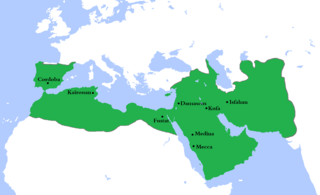The 740s decade ran from January 1, 740, to December 31, 749.

Year 744 (DCCXLIV) was a leap year starting on Wednesday of the Julian calendar. The denomination 744 for this year has been used since the early medieval period, when the Anno Domini calendar era became the prevalent method in Europe for naming years.

Carloman was the eldest son of Charles Martel, mayor of the palace and duke of the Franks, and his wife Chrotrud of Treves. On Charles's death (741), Carloman and his brother Pepin the Short succeeded to their father's legal positions, Carloman in Austrasia, and Pepin in Neustria. He was a member of the family later called the Carolingians and it can be argued that he was instrumental in consolidating their power at the expense of the ruling Merovingian kings of the Franks. He withdrew from public life in 747 to take up the monastic habit, "the first of a new type of saintly king", according to Norman Cantor, "more interested in religious devotion than royal power, who frequently appeared in the following three centuries and who was an indication of the growing impact of Christian piety on Germanic society".

Lotharingia was a medieval successor kingdom of the Carolingian Empire. It comprised present-day Lorraine (France), Luxembourg, Saarland (Germany), Netherlands, most of Belgium, and Germany west of the Rhine. It was named after King Lothair II, who received this territory as his share of the Kingdom of Middle Francia which his father, Lothair I, had held.

Fritzlar is a small town in the Schwalm-Eder district in northern Hesse, Germany, 160 km (99 mi) north of Frankfurt, with a storied history.

Alamannia, or Alemania, was the kingdom established and inhabited by the Alemanni, a Germanic tribal confederation that had broken through the Roman limes in 213.

Saint Pirmin, was a Merovingian-era monk and missionary. He founded or restored numerous monasteries in Alemannia (Swabia), especially in the Alsace, along the Upper Rhine and in the Lake Constance region.

Boniface III, son of Tedald of Canossa and the father of Matilda of Tuscany, was the most powerful north Italian prince of his age. By inheritance he was count of Brescia, Canossa, Ferrara, Florence, Lucca, Mantua, Modena, Pisa, Pistoia, Parma, Reggio, and Verona from 1007 and, by appointment, margrave of Tuscany from 1027 until his assassination in 1052.

Saint-Hippolyte is a commune in the Haut-Rhin department in Grand Est in north-eastern France.

Sadalberga was the daughter of Gundoin, Duke of Alsace and his wife Saretrude. Sadalberga founded the Abbey of St John at Laon. She is the subject of a short hagiography, the Vita Sadalbergae.
Gundoin was the first Duke of Alsace in the middle of the seventh century. He was a Frankish nobleman from the Meuse-Moselle basin. He was, according to the author of the Vita Sadalbergae, an "illustrious man, opulent in wealth and fame according to the highest secular dignity and skilled in courtly affairs."
The Duchy of Alsace was a large political subdivision of the Frankish Empire during the last century and a half of Merovingian rule. It corresponded to the territory of Alsace and was carved out of southern Austrasia in the last decade of the reign of Dagobert I, probably to stabilise the southern reaches of Austrasia against Alemannia and Burgundy. By the late Middle Ages, the region was considered part of Swabia.

Adalrich, also known as Eticho, was the Duke of Alsace, the founder of the family of the Etichonids and an important and influential figure in the power politic of late-seventh-century Austrasia. He may possibly be a progenitor of the House of Habsburg.
Adalbert was the Duke of Alsace beginning after 683 and probably until his death. He was the second duke of the family of the Etichonids and the first to inherit the duchy from his father.
The Etichonids were an important noble family, probably of Frankish-Burgundian origin, who ruled the Duchy of Alsace in the Early Middle Ages. The dynasty is named for Eticho, who ruled from 673 to 690.

Saint Germanus of Granfelden was the first abbot of Moutier-Grandval Abbey. He is venerated as a martyr saint in the Catholic and Eastern Orthodox Churches.
Heden, Hedan, or Hetan II, called the Younger, was a Duke of Thuringia, one of the "older" stem duchies (Stammesherzogtums), from around 700 until his death. He may have been the Hedan who married Saint Bilihild.
Eustace of Luxeuil, also known as Eustasius, was the second abbot of Luxeuil from 611. He succeeded his teacher Columbanus, to whom he had been a favorite disciple and monk. He had been the head of the monastic school.

Moutier-Grandval Abbey was a Benedictine abbey near the villages of Moutier and Grandval in today's Bernese Jura, Canton of Bern in Switzerland. It was founded around 640, when Grandval already existed; Moutier grew up around the abbey.

Weissemburg Abbey, also Wissembourg Abbey, is a former Benedictine abbey in Wissembourg in Alsace, France.












